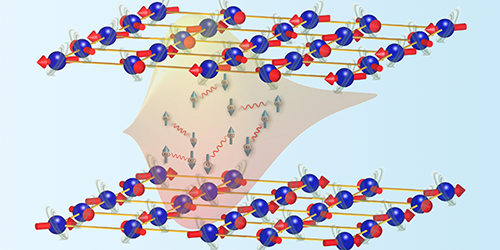Spin Fluctuations May Drive Iron-Based Superconductivity
In conventional superconductors, the mechanism that makes electrons pair up and flow without resistance is reasonably well understood. In unconventional, iron-based superconductors, however, the spins of current-carrying electrons interact with the magnetic moments of the iron atoms, adding a complication that makes the phenomenon harder to explain. Huiqian Luo of the Chinese Academy of Sciences and colleagues have set out to clarify physicists’ understanding of superconductivity in these materials by characterizing the spin dynamics in the iron pnictide superconductor CaK(Fe1−xNix)4As4 [1].
CaK(Fe1−xNix)4As4 is a bilayer compound in which layers of iron nickel arsenide separate alternating layers of calcium and potassium. One of the magnetic orders exhibited by this material is known as a “spin-vortex crystal,” in which the iron atoms sit on a square lattice with their spins pointing toward the centers of the squares. Luo and colleagues used polarized neutron scattering to probe the spin fluctuations of a sample in which this spin-vortex order coexists with superconductivity.
The researchers found that the spins experienced low-energy spin fluctuations, which tended to rotate the spin axes to an alignment perpendicular to the iron nickel arsenide layers. They attribute this preferred fluctuation axis to spin-orbit coupling between iron atoms and itinerant electrons. The team also observed that this preference was strongest in the superconducting regime but persisted well above the critical temperature. They suggest, therefore, that the effect offers a potential superconducting mechanism: As the material cools toward its critical temperature, the fluctuations promote superconductivity by assisting itinerant electrons to pair up.
Previous research has found that other magnetic orders of iron pnictide superconductors also exhibit this preferred spin-fluctuation direction. Luo and colleagues say that this suggests a common mechanism for spin-driven superconductivity across all such materials.
–Sophia Chen
Sophia Chen is a freelance science writer based in Columbus, Ohio.
References
- C. Liu et al., “Preferred spin excitations in the bilayer iron-based superconductor CaK(Fe0.96Ni0.04)4As4 with spin-vortex crystal order,” Phys. Rev. Lett. 128, 137003 (2022).




